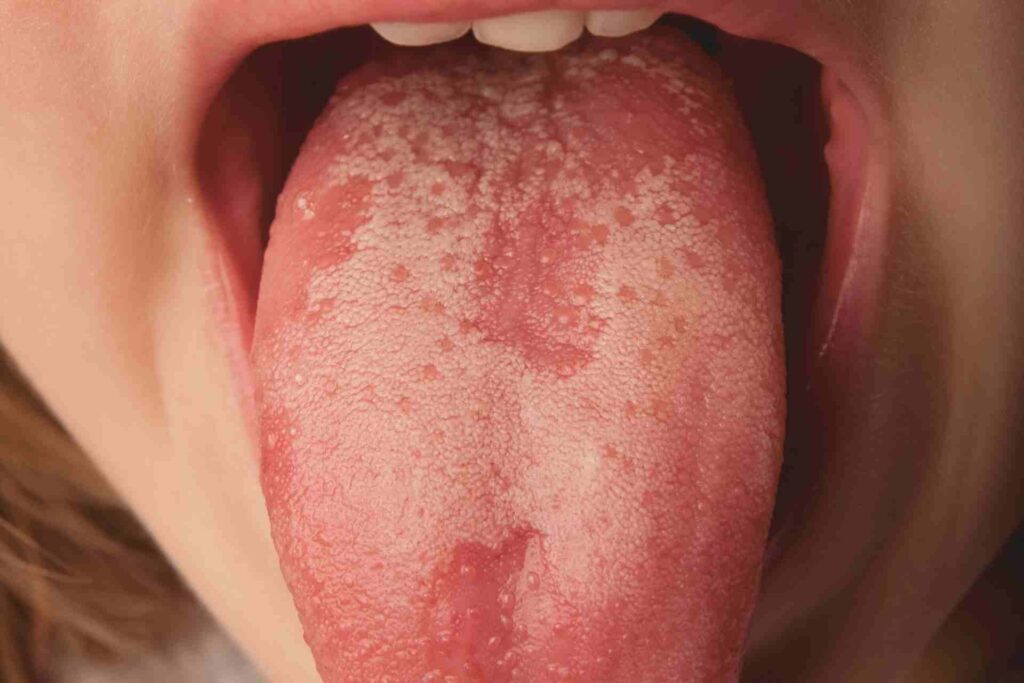Caviar tongue is a harmless condition where you might notice small, dark, bead-like spots showing up under your tongue. It’s often related to aging, but sometimes it hints at other health issues. The name comes from the way the veins resemble caviar, those fancy fish eggs.
Usually, it’s no big deal, but if you see these spots, it’s a good idea to chat with your dentist to make sure everything’s alright. Regular dental visits can help keep track of your oral health and ensure caviar tongue isn’t pointing to a bigger issue.
Is Caviar Tongue Dangerous?

Usually, caviar tongue is nothing to worry about—it’s just a natural part of getting older. However, sometimes it can hint at other health issues like venous insufficiency or systemic diseases.
- Check your tongue regularly
- Pay attention if you have other symptoms alongside these spots.
- If you notice these spots, it’s good to stay aware.
If these spots cause discomfort or look different than before, it’s smart to see a healthcare professional. Your dentist often is really helpful, as they’re great at figuring out what’s normal aging and what might be something else.
Keeping your dentist in the loop helps you stay informed and proactive about your oral health, protecting you from any potential problems. Regular dental visits give you peace of mind and the expertise needed to keep your mouth healthy as you age.
What Causes Caviar Tongue?
Primary Causes:
- Aging: As we get older, it’s normal for the veins under our tongues to lose some elasticity and become more noticeable. This tends to happen more after 50, so it’s just one of those natural signs of getting older.
- Genetics: If your family has a history of vascular issues, you might be more prone to developing caviar tongue. Being aware of your genetic background can be helpful in keeping an eye on your oral health.
- Lifestyle Factors: Smoking and not taking care of your oral hygiene can make caviar tongue more apparent. Smoking can affect blood flow and lead to larger veins, while poor oral care might bring about other issues too.
Secondary Causes:
- Underlying Health Conditions: At times, noticing a caviar tongue could hint at issues like poor blood circulation or even high blood pressure. These can affect the veins under your tongue, so it’s always good to keep an eye on overall health.
- Systemic Diseases: Though rare, caviar tongue might be connected to bigger health issues like liver problems or blood clots. If you think there’s more going on, reach out to a doctor to look after both your oral and overall health.
When Should You Be Concerned?

While caviar tongue is usually harmless, certain signs should prompt a visit to your healthcare provider. Be attentive to the following:
- Frequent Bleeding: If the spots under your tongue begin to bleed regularly, it’s essential to get them checked. Bleeding could indicate irritation or another underlying problem.
- Swelling or Appearance Changes: Persistent swelling or noticeable changes in the spots can be signs of potential complications that need further investigation.
- Systemic Symptoms: If you experience symptoms like unusual fatigue or skin changes, these might point to broader health concerns. In such cases, a comprehensive evaluation would be beneficial.
Treatment Options for Caviar Tongue
Often, caviar tongue is no big deal and doesn’t need any treatment. It’s just a part of aging, like getting gray hair or wrinkles. If it doesn’t bother you and your dentist says everything’s fine, there’s usually nothing to worry about. Just keep up with regular dental visits and good oral care, and you should be all set.
Medical and Lifestyle Interventions

While treatment isn’t always necessary, some people might choose to address caviar tongue for cosmetic or health reasons. Here’s what you can consider:
- Laser Therapy: If you’re looking to reduce the appearance of these veins for cosmetic reasons, laser therapy is a great option. It’s minimally invasive, relatively painless, and quick, helping to make the veins less noticeable.
- Improving Oral Hygiene: Keeping your mouth clean with regular brushing and flossing is really important. Good oral hygiene can help prevent irritation or infection that might make the condition worse.
- Managing Health Conditions: If caviar tongue is linked to issues like venous insufficiency or hypertension, addressing these is crucial. Talk to your healthcare provider to manage your health effectively.
FAQs About Caviar Tongue
Is Caviar Tongue Permanent?
Caviar tongue is often a natural and permanent part of the aging process. As we get older, the veins under our tongues may become more noticeable and stay that way. However, it generally does not lead to any health issues. It’s just another sign of the body’s natural aging journey.
Does Caviar Tongue Hurt?
Typically, caviar tongue is painless and not something you’ll feel day to day. The spots or veins look more pronounced but don’t cause discomfort unless they’re irritated by something like rough brushing or acidic foods. If you ever feel pain or irritation, it’s worth checking in with your dentist.
Can Caviar Tongue Be Prevented?
While we can’t stop aging, you can minimize the risks of caviar tongue by maintaining excellent oral hygiene and a healthy lifestyle. Brushing and flossing regularly, avoiding smoking, and managing underlying health conditions can all contribute to better oral health. Keeping these habits in mind will help you take charge of your dental wellness.
Key Takeaways

- Natural Aging Process: Caviar tongue is a normal part of aging, often seen after age 50, due to more noticeable veins under the tongue.
- Genetic and Lifestyle Factors: Genetics and lifestyle choices like smoking can increase the visibility of veins associated with caviar tongue.
- Health Monitoring: Be aware of systemic health conditions that might exacerbate caviar tongue, such as poor blood circulation or high blood pressure.
- When to Seek Advice: Consult a healthcare provider if you notice frequent bleeding, swelling, appearance changes, or systemic symptoms.
- Treatment Options: Most cases require no treatment, but options like laser therapy are available for cosmetic concerns, and good oral hygiene is always recommended.
Stay informed and proactive about your dental health by following us on social media for more tips and updates: @joycethedentist.





















